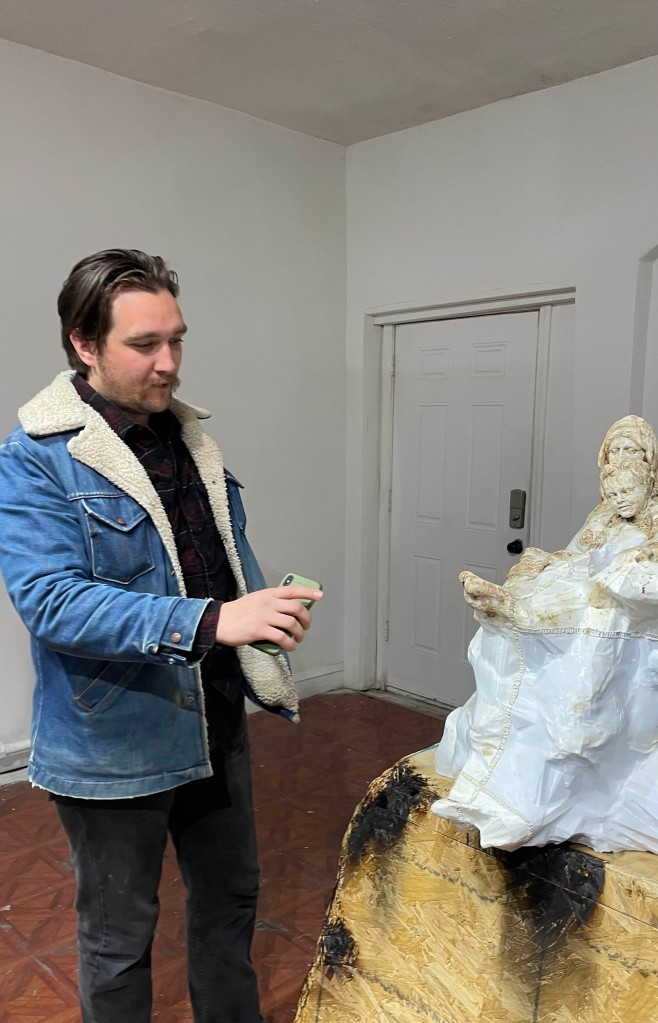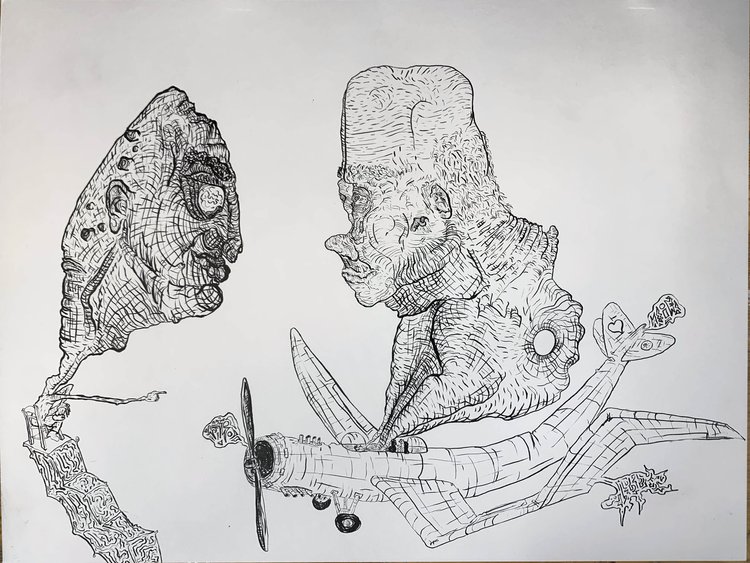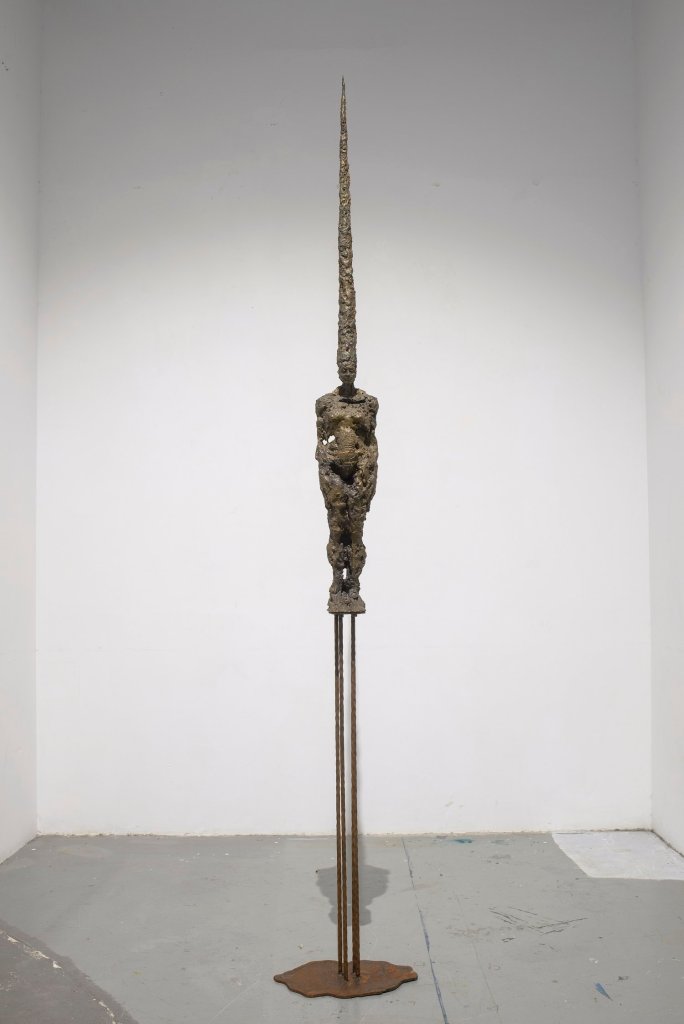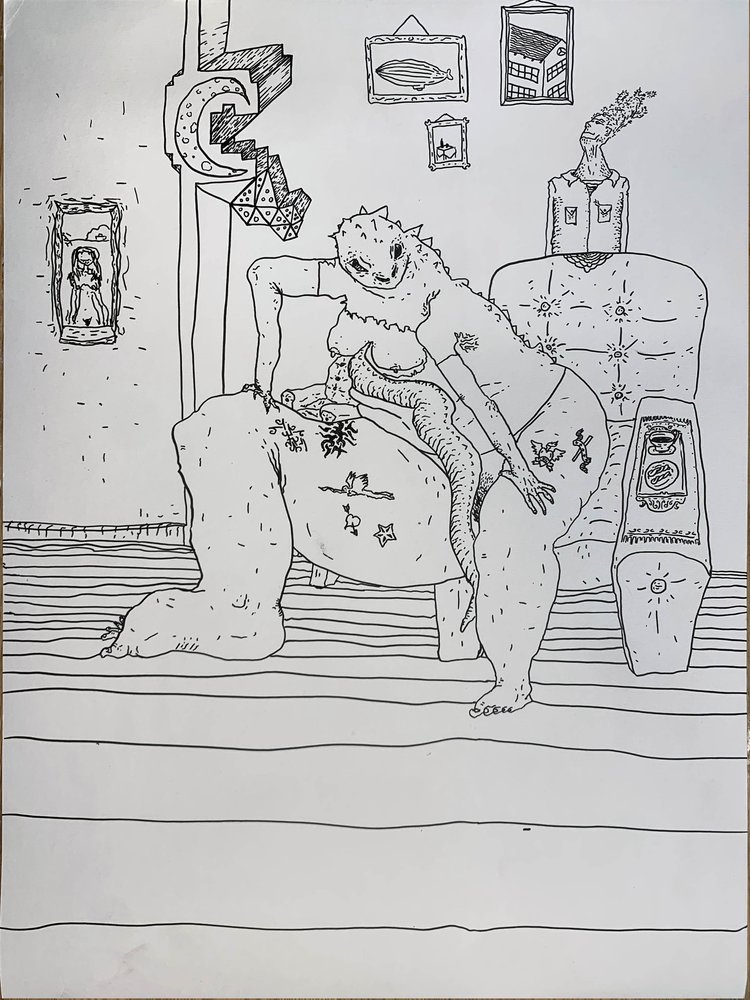Stella Sevastopoulos talks to Chicago-based Greek artist Tasos Mylonas about his new exhibition ‘Peacetime Proxy’, his life as an artist in Chicago, the trials and tribulations at ASFA, and the charismatic teacher George Lappas. Plus, the violence inherent in nature, human nature and art, but also why a right-handed artist’s unskilled left hand, might be more honest.
“People sleep peaceably in their beds at night only because rough men stand ready to do violence on their behalf.”
― George Orwell
TASOS MYLONAS is an artist whose sublime configuration of formal elements, driven by diverse forces and influences, merge to create sculptural forms that create dialogues on the complexities and ironies of humanity and human existence. His exploration of automatism in his drawings, but even the fluidity of the molding and casting processes of his sculptural forms, testify towards his ability to delve into the collective unconscious, even via the route of his own dreams and nightmares, which he brings to light in his art. Yet by connecting the images from his subconcious with other images, aspects, and mediums of contemporary society, he creates food for thought via an artistic process which goes beyond personal exploration, and aims towards unveiling the driving forces behind our societies. Battling with the demons of both contemporary society and those of his own, he explores his mediums with ingenuity and originality, at times fusing into them aspects from the art of past masters that have inspired him, in order to interpret them anew.

From ancient Athenian marble reliefs and the drapes of the figures on the Parthenon Marbles, to the spindly tall figures of Giacometti, and from references to medieval and renaissance art, but also the graphics of cartoons and video games – the influential elements in Mylonas’s work are ubiquitous, and transformed through his contemporary approach and perspective which is firmly placed in the 21st century. Infused with a psychological twist which pertains towards revealing the paradoxes of human nature, this artist can blend conceptual, figurative and digital art with his passion and deep-founded knowledge of music. Imbued with harmony and rhythm, Mylonas’s sculptures are visual statements which often reveal bitter truths via their lyrical yet dynamic formal relations.

From his use of traditional clay, plaster, and wax to contemporary metal, 3D printing, and lightning installations, Mylonas is interested in using his mediums in order to create dialogues on representation, authenticity, and gesture. Evident also is his interest in mold-making, casting, reproduction, and metal fabrication. However, Mylonas’s incorporation of industrial materials into his sculptures, such as iron bar, add another dimension to his sculptures. The addition of this particular material for him is symbolic, and inspired by the many semi-finished architectural constructs in Greece, which leave the iron bars bare, with the promise of a new floor to be built onto them. They symbolise the hope from a promise of a better future.
Born in 1987, Mylonas graduated from the Athens School of Fine Arts (ASFA) in 2019 with honors, having studied in the workshops of artists George Lappas, Andriana Verveti, Pavlos Samios, Markos Georgilakis, and Afrdoditi Liti, all of whom influenced his artistic course in their own unique manner. He then decided to spread his wings and to complete an MFA at the School of the Art Institute of Chicago (completed in 2023). He has been a recipient of the Neon Grant twice, winner of the Ethniki Asfalistiki young artist competition, and was granted a prestigious scholarship from SAIC. He has participated in exhibitions both in Greece and the United States and has decided to stick to Chicago for the time being, eager to absorb all that the USA has to offer young artists.

Mylonas’s current projects revisit observation through memory, and the question of reengagement with the human element in sculpture. His recent solo exhibition in Chicago, at the space Parlour and Ramp, titled ‘Peacetime Proxy’ (April 12-26, 2024), which included some of these recent sculptural ‘observations’ and ‘reengagements’, was met with appraisal and enthusiasm. In this exhibition, man and beast are intertwined in some of the pivotal works, which could be interpreted as our inability to free ourselves from certain ‘animal instincts’. Tacy Wagner’s catalogue essay explained the following about this exhibition:
“Peacetime Proxy intimates the inherent contradiction of opposing factions attempting to influence affairs without direct engagement. Tasos Mylonas considers, perhaps paranoically, the inevitability of our engagements with violence. Impressions adhere, horrors render themselves in our minds; everything has violent potential, but everything too has already received it.
A concern with the entropy of the material world and a very physical approach to the process of making ground these works. The forms give way to a delicate material complexity as if the fundamentals of sculpture-to- model, have become unmoored from time and history and now live across figure, found object, computer, printer, clay, PLA, media file. Mylonas strips figures and forms down to various essences then rebuilds them in a non-synchronous space where digital and physical processes bridge new mythologies.”

What follows is an interview with Tasos Mylonas, where he delves into his past, the years at the Athens School of Fine Arts (ASFA), memories of the charismatic artist George Lappas (who sadly passed away in 2016), life in Chicago, plus the reason d’etre behind some of his most poignant works:
- Let’s start with a discussion of some of your earlier works, such as ‘Study on a Fever Dream’ (2018). The way I interpret it, it is the way that the ‘mother’ is always at the back of our heads. Psychology is stressing these days all the more the influence, good and bad, that the mother has on her children. Her head is large and ominous in this work of yours. Is this an interpretation that you intended? Or is there something else you wanted to say with this work?
- The psychological elements and interpretations are there for each viewer to reflect upon differently. I believe art can provide this plurality of interpretation, and each interpretation is accurate. Personally, this piece was pivotal for me; it was made at a time when our studio in ASFA was under a semiautonomous operation led by the students. I started working on it after my professor, George Lappas, tragically died in 2016. This coincided with the time I returned from completing my military service and returned to my studies after a year break. The conceptual and spatial-poetic foundations that Lappas provided me with, were invaluable and unparalleled. I am fortunate to have been part of his group of students. However, I was also urged to engage in a classical study because I wanted to link with the past masters who inspired me. So, I made a study of a x2.5 larger-than-life portrait from a real-life model. During that period, I also worked on small reclining figures of the same model. My idea was to upgrade the studies into a fusion piece that would suspend in space. I always had this dream (literally a fever dream) of a sense of loss of proportion and intense contrast between materials, weight, and texture. All of which are elements of this sculpture.
- This semi-autonomous state of the workshop at ASFA led by students sounds interesting. Was it chaotic or did some interesting things happen due to it?
- It’s a mixed bag. The obvious answer is that it was problematic for most students. However, I found it an excellent time to delve into some aspects of sculpture that interested me. I would lie if I said it was not a productive year.

- Your choice of materials is interesting, tell us about how you gravitated initially towards the use of materials such as cast lead and polyurethane foam and polyester resin. I get the sense that you enjoy the casting process in particular. However, in this you also mix the use of some rebar, a builder’s material which you use as a base for your works.
- I chose these specific materials according to their capacity to add to the symbolism I wanted to evoke. Material is often the most crucial element for sculpture. Lead and polyurethane foam were selected in the work ‘Study on a Fever Dream’, for example, because of their physically contradicting properties, features, and appearance. The rebar is also symbolic as it nods to the landscape or cityscape I grew up around, especially in how you see it coming out of rooftops and foundations for the possibility of extension and further building. I liked it as a symbol of continuity. Mold-making and casting have been a big part of my practice, and the processes hugely influence the result. The same goes for resins. They look and feel like plastic, a worldly material we interact with like second nature.
- Lappas was a very charismatic artist. What aspects of his teachings and perspective on art struck a chord in you? Molded you as an artist? Or affected your artistic process or direction?
- He was unique indeed. Extensively educated, he was from a generation with vastly different experiences and a different outlook on art and life. And yes, he was also very charismatic. I still remember the exercises he presented us with every semester: a series of abstract, poetically delivered propositional sentences. They were intriguing, dense, and also calculated. A core principle of his approach to sculpture, could be loosely translated into English as “Vertigo of Space” or “Vertigo in Space.” He definitely molded me as an artist. Imposing personalities like Lappas require students to find a way around them as well, for as great as they are, they have to be overcome!

- ‘Netflix & Chill’ (2019), is another earlier work I love, because it reflects on an aspect of today’s society and how we have all melted into our sofas watching netflix! (Especially during the pandemic). What are your views of this culture of today which is becoming all the more glued to screens?
- Thank you! This piece came from a very personal attempt to reconcile and bring closure. As an artist, I have a superstitious trait, and I sometimes consider my work a way to pay respect to something. Whether that is a person, a relationship, or even a sofa! So, a sculpture can function as an offering. In our cultural period, the ‘altar’ to which art is meant to be dedicated to, is society. So, this personal dedication resonates with societal reality as if it were a contemporary ethnography. The title nods to the internet slang euphemism for sexual activity and adds a tragicomic layer. I also used an old projector in this piece to project a grid that would glide repetitively over the surface of the concrete sculpture and imitate the motion of a screen.

- Your drawings, created during the pandemic years, suggest that at this stage you went through a kind of catharsis, where you just got everything out on the paper. How did the pandemic affect you? For some artists it was an opportunity to work more.
- The pandemic unfortunately coincided with the beginning of almost 3/4 of my postgraduate studies. For many artists, grad school is not what they expected, and considering the circumstances, mine was not either. This series of work has also been a turning point for my practice. The tradition of automatic writing and surrealism is a place where I identify and trace this work while simultaneously circumnavigating terms like deskilled figuration. It started with drawing using only my left hand as a right-handed person, thus forcing my brain and muscles to produce something I otherwise would have had predetermined forms and pathways for. It is also a more spiritual way to draw in terms of being less capable or inclined to produce a result that cares or places the rendering in such high priority. In essence, these drawings examine the dream world and the unconscious. I don’t know how they could be related to the pandemic or if they are driven by it to an extent, but I won’t rule out the possibility. It was a challenging and restrictive time for all of us. However, artists frequently need to invent a sort of restriction or rule that they apply to themselves, so in a way, my use of the left hand is a symbolic gesture for this approach as well.
- I’m inclined to think that because Covid-19 was a dive into the unknown for many of us, this also might reflect in some artists’ choices during this time. For example: the fact you chose to grapple with something that wasn’t entirely under your control, by using your left hand, going towards automatism and the unknown, was exploration of new territory let’s say.
- As I mentioned, a lot of social distancing, lockdowns, mandates, and other restrictions during Covid-19 affected much of my Postgraduate course. However I don’t entirely associate the series with Covid-19. Many artists find a subset of self-inflicted rules for their practice, and they abide by them to find a unique and recognizable style. It is generally part of my approach to sculpture and art, in general, to try always challenge myself with something unknown. I feel I almost have an obligation to my audience. Drawing with the left hand is perhaps an attempt to maintain a sense of honesty.

- ‘Ambition with Hat’ (2019), is also an interesting work. So many people are highly ambitious these days, this person in your work included! The pointed hat this person is wearing in your work is so tall (and ambitious) that it has turned into a weapon, a kind of spear head. Ambition can do that to a person. Do you agree?
- In this work, I combined the rigidity and verticality of archaic sculpture with the pointed hat you would see in Goya. You are correct that it appears weaponlike and fused with the figure hovered mid-air. This symbolic hat has many different representations, from being the witch’s hat to being the fool’s hat, to be used as a form of punishment and ridicule. Still, I wanted the piece to preserve its formality. I named her ‘Ambition’ to personify this idea in this figure that stands suspended in mid-air.
- What is your art philosophy? Who are the artists and writers that have influenced your work?
- My practice is influenced by things often slightly related or completely unrelated to art and sculpture. I have an affinity for learning about historical events, and I appreciate learning about all things related to geography and the psychosocial elements adherent to that. It is hard to focus on a few artists or writers that have influenced my work. Still, I certainly have been influenced a lot by philosophy, the ancients like the presocratics and Plato, medieval symbolic thought, Kant and the concept of the sublime, the school of Schopenhauer and Nietzsche, and many more. My artistic influence follows a similar thread. I hold dear my upbringing around classical and medieval art, and even though it is distant and more difficult to relate to, it always functions in various ways as a figurative modulus for my work.
- Your recent work has shown a move towards exploring other materials.
- Yes, my most recent work has embraced various other processes and materials, including digital fabrication through 3D scanning and printing. This current approach has allowed me to incorporate materials such as PLA, bonded sand, and various found objects into my sculptures. A recurring theme in my work is the balance between monumentality and entropy, questioning the permanence or transience of the artwork.

- Your recent exhibition ‘Peacetime Proxy’ deals with the inevitability of violence. Explain to us a little about how the works in this exhibition deal with this concept.
- The concepts I work with usually appear soon after I begin. For example, I may have an intuition or a reaction to something I observe and start working on a piece, and then more things somehow assemble themselves. The work comes together under a concept I must reveal to myself. So, ‘Peacetime Proxy’ seems like an oxymoron at first glance, but then I contemplate the idea that every artwork is a form of a proxy agent that confronts the viewer.
- Would you consider your works to be didactic?
- I want to avoid making art that is directly didactic or moralistic, but at the same time, I have to work on things that I also find worrying and horrifying. In the works for ‘Peacetime Proxy’, I combined my sustained interest in history and geopolitics, filtered by how we interact with world warfare events, particularly violent ones, directly from social media. For example, I made a video for this show based on the hundreds of videos of drone attacks on sleeping or unaware soldiers in trenches being exterminated.
- What was the reaction of the public/visitors to the works in the ‘Peacetime Proxy’ exhibition?
- I was pleased with the reaction; the opening coincided with EXPO Chicago, the annual Chicago Art Fair, and every gallery in the city had an opening or an event. Yet, I was really surprised by the turnover, it exceeded my expectations. Having a solo show takes a lot out of you, and it will take some time for me to evaluate the feedback and its effect on the viewers and me.
- There is a sculpture titled ‘Proxy 2’, of a woman and child with a cat in this exhibition, which contrasts with some of the other images that deal with war and violence. Tell us about this piece.
- The piece with the woman and the child with a cat have a double role: On the one hand, it is a narrative symbol of symbiosis concerning the figures and their foundation. I was inspired by a scene I saw in Pilsen, the neighborhood where I live in Chicago, where a woman in an electric wheelchair held who I assumed to be her daughter on her lap, and the little girl had a tiny kitten in a small tub. Most of the piece is articulated with 3d printed blocks fused together with heat after printing. After my initial digital design and 3d print, I used polymer clay to render the features I wanted on top and moved away from the original source. In the context of the show, I envision this piece as a monument. To underscore this concept, I chose a pyramid-shaped pedestal reminiscent of a mound or tomb. This deliberate choice of presentation amplifies the artwork’s symbolic significance, encouraging viewers to contemplate it like that. Some cultures use the term ‘motherland’ instead of ‘fatherland’ when referring to their country or the land of their ancestors. It is about the psychological and propagandistic foundations of battle, drawing on the symbolism of the ‘motherland’ concept.

- What about the piece titled ‘Proxy 4’, placed in front of it? It reflects more on war.
- For the piece placed in front of it on the wall, I made a man riding backward on a terrain resembling a map. My reference was the ‘Jockey of Artemision’ sculpture from the Archaeological Museum of Athens. A young boy riding a massive horse that almost reads allegorically, symbolizing the often-pushed association between wilderness and human intention. The boy’s face looks terrified, and it also reminds me of the actor from the Russian war film ‘Come and See.’ The wall piece is also made by hand in conjunction with 3D printing and comprises 3D scanned objects like chicken bones from takeout food, formulating an absurd geographic relief map.
- Is violence inherent in men?
- I believe it is. Men are indeed the instigators of warfare. However, violence is inherent in Nature and, more importantly, doesn’t have a moral code. The angle with which I like to approach the issue of violence, is to observe how we decide to differentiate ourselves from it and apply rules for it. The philosophical concern with human nature and nature being separate, and where the line is drawn between them, is an issue that I navigate. My work, of course, is not an answer, and I don’t aspire for it to be one, nor is it a fatalistic realization. Art is, for me, in part, an outlet for violence. I used to believe that a sculptor could encapsulate a pulse within an artwork (especially in the early stages of making), which resonates with the immersed viewer. Visual art, especially in the 20th century, tried to address the violent gesture.
- Why did you choose to go to the Chicago Institute of Fine Arts for your MFA and how was this learning experience?
- I chose to come to America because I always wanted to see this country. It felt like the right time; I was granted an extraordinary scholarship and was ready for an adventure. The School of the Art Institute of Chicago, aside from having an excellent reputation as a school, also has the uniqueness of being placed in the downtown area of a big city while also being attached to the museum. I chose this school after a few other options and don’t regret it. The learning experience was intriguing and challenging, as SAIC is a conceptually oriented school. In my experience with both ASFA and SAIC, the individuals that comprise the cohort and the community at large can significantly impact your education in the arts. Sometimes even more so than the institution’s facilities and professors.
- I would say that for many artists, it is the big dream to go to America and make it there as an artist. What would you say to them, and how would you describe your life as a Greek artist living in America?
- Obviously, the opportunities are here, and it goes without question that it is the primary reason for someone to try it if they desire to. It is true, though, that in Greece, people are more accustomed to a spontaneous lifestyle, especially among the youth. The most striking difference between Athens and a big American city like Chicago is the city’s sense of quietness and seemingly weak pulse. It can also be a challenging and often hostile place. However, there is much to gain as an artist from stepping out of one’s comfort zone and embracing a culture with its own norms and taboos. Even more so when that culture undergoes a crisis of growth and realization. This moment can be foundational for helping one invest in their self-actualization as an artist.
For more info on the artist you may visit his site

‘Art Scene Athens’ is written/run by artist/journalist Stella Sevastopoulos. Dedicated to presenting what is happening on the Greek art scene (but not only), and also to giving Greek artists an international voice on the internet. Press releases etc and proposals for features/articles may be sent to stelsevas@yahoo.com. For more on Stella Sevastopoulos’s art, click here